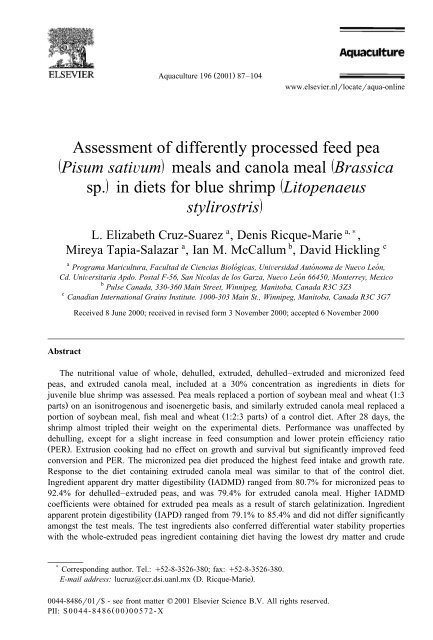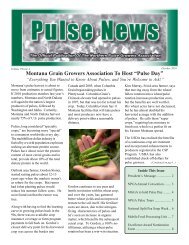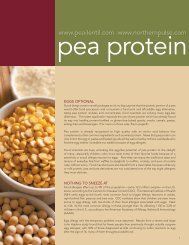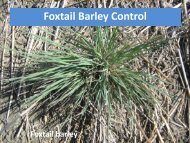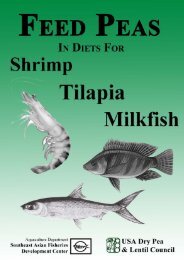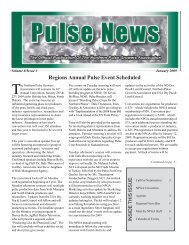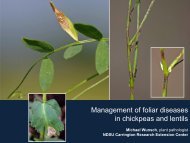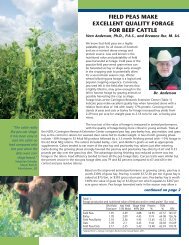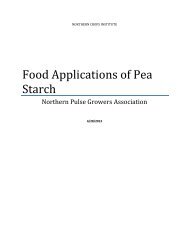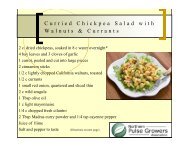Processed feed pea and canola meal for blue shrimp diets
Processed feed pea and canola meal for blue shrimp diets
Processed feed pea and canola meal for blue shrimp diets
Create successful ePaper yourself
Turn your PDF publications into a flip-book with our unique Google optimized e-Paper software.
Ž .<br />
Aquaculture 196 2001 87–104<br />
www.elsevier.nlrlocateraqua-online<br />
Assessment of differently processed <strong>feed</strong> <strong>pea</strong><br />
ž Pisum satiÕum/ <strong>meal</strong>s <strong>and</strong> <strong>canola</strong> <strong>meal</strong> žBrassica<br />
sp. / in <strong>diets</strong> <strong>for</strong> <strong>blue</strong> <strong>shrimp</strong> žLitopenaeus<br />
stylirostris/<br />
L. Elizabeth Cruz-Suarez a , Denis Ricque-Marie a,) ,<br />
Mireya Tapia-Salazar a , Ian M. McCallum b , David Hickling c<br />
a Programa Maricultura, Facultad de Ciencias Biologicas, ´ UniÕersidad Autonoma ´ de NueÕo Leon, ´<br />
Cd. UniÕersitaria Apdo. Postal F-56, San Nicolas de los Garza, NueÕo Leon ´ 66450, Monterrey, Mexico<br />
b Pulse Canada, 330-360 Main Street, Winnipeg, Manitoba, Canada R3C 3Z3<br />
c Canadian International Grains Institute. 1000-303 Main St., Winnipeg, Manitoba, Canada R3C 3G7<br />
Received 8 June 2000; received in revised <strong>for</strong>m 3 November 2000; accepted 6 November 2000<br />
Abstract<br />
The nutritional value of whole, dehulled, extruded, dehulled–extruded <strong>and</strong> micronized <strong>feed</strong><br />
<strong>pea</strong>s, <strong>and</strong> extruded <strong>canola</strong> <strong>meal</strong>, included at a 30% concentration as ingredients in <strong>diets</strong> <strong>for</strong><br />
juvenile <strong>blue</strong> <strong>shrimp</strong> was assessed. Pea <strong>meal</strong>s replaced a portion of soybean <strong>meal</strong> <strong>and</strong> wheat Ž1:3<br />
parts.<br />
on an isonitrogenous <strong>and</strong> isoenergetic basis, <strong>and</strong> similarly extruded <strong>canola</strong> <strong>meal</strong> replaced a<br />
portion of soybean <strong>meal</strong>, fish <strong>meal</strong> <strong>and</strong> wheat Ž 1:2:3 parts.<br />
of a control diet. After 28 days, the<br />
<strong>shrimp</strong> almost tripled their weight on the experimental <strong>diets</strong>. Per<strong>for</strong>mance was unaffected by<br />
dehulling, except <strong>for</strong> a slight increase in <strong>feed</strong> consumption <strong>and</strong> lower protein efficiency ratio<br />
Ž PER .. Extrusion cooking had no effect on growth <strong>and</strong> survival but significantly improved <strong>feed</strong><br />
conversion <strong>and</strong> PER. The micronized <strong>pea</strong> diet produced the highest <strong>feed</strong> intake <strong>and</strong> growth rate.<br />
Response to the diet containing extruded <strong>canola</strong> <strong>meal</strong> was similar to that of the control diet.<br />
Ingredient apparent dry matter digestibility Ž IADMD.<br />
ranged from 80.7% <strong>for</strong> micronized <strong>pea</strong>s to<br />
92.4% <strong>for</strong> dehulled–extruded <strong>pea</strong>s, <strong>and</strong> was 79.4% <strong>for</strong> extruded <strong>canola</strong> <strong>meal</strong>. Higher IADMD<br />
coefficients were obtained <strong>for</strong> extruded <strong>pea</strong> <strong>meal</strong>s as a result of starch gelatinization. Ingredient<br />
apparent protein digestibility Ž IAPD.<br />
ranged from 79.1% to 85.4% <strong>and</strong> did not differ significantly<br />
amongst the test <strong>meal</strong>s. The test ingredients also conferred differential water stability properties<br />
with the whole-extruded <strong>pea</strong>s ingredient containing diet having the lowest dry matter <strong>and</strong> crude<br />
) Corresponding author. Tel.: q52-8-3526-380; fax: q52-8-3526-380.<br />
Ž .<br />
E-mail address: lucruz@ccr.dsi.uanl.mx D. Ricque-Marie .<br />
0044-8486r01r$ - see front matter q 2001 Elsevier Science B.V. All rights reserved.<br />
Ž .<br />
PII: S0044-8486 00 00572-X
88<br />
( )<br />
L.E. Cruz-Suarez et al.rAquaculture 196 2001 87–104<br />
Ž .<br />
protein CP loss following a 1-h immersion in water. This study showed that whole raw <strong>feed</strong> <strong>pea</strong><br />
is a very acceptable ingredient <strong>for</strong> <strong>blue</strong> <strong>shrimp</strong> <strong>diets</strong>; extrusion cooking improved <strong>feed</strong> conversion<br />
ratio <strong>and</strong> PER, <strong>and</strong> micronizing <strong>pea</strong>s enhanced <strong>feed</strong> intake, while dehulling had no effect. q 2001<br />
Elsevier Science B.V. All rights reserved.<br />
Keywords: Crustacean; Nutrition; Growth; Digestibility; Peas; Canola<br />
1. Introduction<br />
Recent reports have described grain legumes or pulses, such as field <strong>pea</strong>s as potential<br />
ingredients <strong>for</strong> aquaculture <strong>feed</strong>s ŽAllan, 1998; Novoa <strong>and</strong> Castillo, 1998; Allan et al.,<br />
1999a; Booth et al., 1999 .. Some reports have indicated that <strong>pea</strong> <strong>meal</strong> is an acceptable<br />
ingredient in <strong>diets</strong> <strong>for</strong> rainbow trout ŽKaushik et al., 1993; Gomes et al., 1993, 1995;<br />
Burel et al., 1996 ., tilapia Ž Fontainhes-Fern<strong>and</strong>es et al., 1997 ., silver perch ŽAllan, 1997;<br />
Allan et al., 1999b; Booth et al., 1999 ., tiger <strong>shrimp</strong> Ž Smith et al., 1999.<br />
<strong>and</strong> Euro<strong>pea</strong>n<br />
sea bass Ž Santos <strong>and</strong> Gomes, 1997; Gouveia <strong>and</strong> Davies, 1998, 2000 .. Peas offer<br />
flexibility in <strong>feed</strong>stuff selection to the <strong>feed</strong> manufacturer as they may replace both grain<br />
Ž e.g., maize corn, wheat. <strong>and</strong> protein Ž e.g., soybean <strong>meal</strong> <strong>and</strong> fish <strong>meal</strong>.<br />
but their use has<br />
been limited due to concerns about the presence of anti-nutritional factors ŽTacon,<br />
1997 .. Studies with rainbow trout have shown that prior heat treatment was necessary to<br />
improve digestibility <strong>and</strong> possibly inactivate anti-nutritional factors ŽKaushik et al.,<br />
1993; Pfeffer et al., 1995 .. Feed <strong>pea</strong>s, the designation <strong>for</strong> the round shaped, low tannin<br />
varieties of Pisum satiÕum, are a major pulse crop marketed extensively in Europe <strong>and</strong><br />
Canada as a source of carbohydrate, mainly starch, <strong>and</strong> protein <strong>for</strong> livestock <strong>feed</strong>s<br />
Ž UNIP-ITCF, 1995 .. As a result of plant breeding, several anti-nutritional factors in <strong>feed</strong><br />
<strong>pea</strong>s including tannins <strong>and</strong> anti-trypsins, have been eliminated or substantially reduced<br />
Ž Castell et al., 1996 ..<br />
Starches are low cost sources of dietary energy <strong>and</strong> are generally well utilized by<br />
<strong>shrimp</strong> Ž Catacutan, 1991; Shiau <strong>and</strong> Peng, 1992; Cruz-Suarez ´ et al., 1994 .. Thermal<br />
processing to gelatinize starch increased its digestibility in <strong>diets</strong> fed to Litopenaeus<br />
Õannamei Ž Davis <strong>and</strong> Arnold, 1993; Cousin et al., 1996 .. However, extrusion conditions<br />
Ž none, wet or dry.<br />
differentially affected energy digestibility coefficients of cereal grains<br />
Ž Davis <strong>and</strong> Arnold, 1995 .. Dehulled <strong>pea</strong>s had higher apparent digestibility coefficients<br />
<strong>for</strong> energy, crude protein Ž CP.<br />
<strong>and</strong> essential amino acids than whole <strong>pea</strong>s when included<br />
in <strong>for</strong>mulated <strong>diets</strong> fed to silver perch Allan Ž 1997 .. Dehulling has also been shown to<br />
improve the nutritional value of leguminous seeds as ingredients in <strong>diets</strong> <strong>for</strong> Penaeus<br />
monodon Ž Eusebio, 1991 ..<br />
Canola <strong>meal</strong> is a particularly rich plant source of sulphur containing amino acids <strong>for</strong><br />
fish <strong>diets</strong> Ž Higgs et al., 1995.<br />
but its potential value as an ingredient in <strong>shrimp</strong> <strong>feed</strong> has<br />
received little attention Ž Buchanan et al., 1997 .. Extrusion processing has also been<br />
shown to improve the nutritive value of <strong>canola</strong> <strong>meal</strong> Ž Satoh et al., 1998 ..<br />
The objective of the present study was to assess growth, nutrient utilization, survival<br />
<strong>and</strong> digestibility in <strong>blue</strong> <strong>shrimp</strong> fed whole, dehulled, extrusion cooked <strong>and</strong> micronized<br />
<strong>feed</strong> <strong>pea</strong>s, <strong>and</strong> extruded <strong>canola</strong> <strong>meal</strong>, <strong>and</strong> held under laboratory conditions.
2. Material <strong>and</strong> methods<br />
( )<br />
L.E. Cruz-Suarez et al.rAquaculture 196 2001 87–104 89<br />
2.1. Diets<br />
A lot of commercial dry <strong>pea</strong>s P. satiÕum composed of mixed Canadian prairie<br />
varieties was processed to prepare the respective <strong>meal</strong>s. Whole <strong>and</strong> dehulled <strong>pea</strong>s were<br />
pin-milled to produce raw flours, WRA <strong>and</strong> DRA, respectively. Portions of these flours<br />
were preconditioned Ž Wenger model 2 DDC.<br />
<strong>and</strong> extruded with a co-rotating twin screw<br />
extruder Ž Werner <strong>and</strong> Pfleiderer ZSK-57.<br />
through 1r4 in. round hole dies at a product<br />
temperature reaching 1458C at the die plate, <strong>and</strong> pressure ranging between 620 <strong>and</strong> 740<br />
psi. The extruder screw was 147 cm long with a lengthrdiameter ratio of 24:1. The<br />
material was fed into the conditioner at a rate of 90.9, 93.6 <strong>and</strong> 113.6 kgrh <strong>for</strong> whole<br />
<strong>pea</strong>s, dehulled <strong>pea</strong>s <strong>and</strong> <strong>canola</strong> <strong>meal</strong>, respectively, <strong>and</strong> water was injected at a rate of 4.5<br />
lrh. The material was then dried in a fluid bed dryer at 1108C <strong>and</strong> pin milled to produce<br />
whole <strong>and</strong> dehulled extruded <strong>meal</strong>s Ž WEX <strong>and</strong> DEX, respectively .. Commercial <strong>canola</strong><br />
<strong>meal</strong> was similarly extruded <strong>and</strong> ground Ž CEX .. Another portion of whole <strong>pea</strong>s was<br />
tempered to 14% moisture <strong>and</strong> processed using infrared cooking, reaching a temperature<br />
of 1208C. The heat-treated Ž micronized.<br />
<strong>pea</strong>s were subsequently rolled to produce a<br />
flake <strong>and</strong> then milled into a fine powder Ž WMI .. The proximate composition <strong>and</strong> effects<br />
of heat treatment on starch gelatinization in the <strong>pea</strong> <strong>meal</strong>s are presented in Table 1.<br />
Isonitrogenous <strong>and</strong> isoenergetic Ž gross energy.<br />
experimental <strong>diets</strong> <strong>for</strong> the growth trial<br />
were <strong>for</strong>mulated to contain 30% of the test <strong>meal</strong>s, <strong>and</strong> to meet the nutrient requirements<br />
Ž Akiyama et al., 1991. with proteinrenergy ratios Ž Cruz-Suarez ´ et al., 2000.<br />
recommended<br />
<strong>for</strong> <strong>shrimp</strong> Ž Table 2 .. The test <strong>pea</strong> <strong>meal</strong>s were included in the experimental <strong>diets</strong><br />
1 to 5 to replace a portion of a soybean <strong>meal</strong> <strong>and</strong> wheat flour mix Ž1:3 parts,<br />
respectively.<br />
in the practical control diet 7. In test diet 6, extruded <strong>canola</strong> <strong>meal</strong> replaced<br />
a portion of soybean <strong>meal</strong>, fish <strong>meal</strong> <strong>and</strong> wheat Ž 1:2:3 parts, respectively ..<br />
Table 1<br />
Proximate analysis of the test ingredients, <strong>and</strong> degree of gelatinization in <strong>pea</strong> starch be<strong>for</strong>e <strong>feed</strong> manufacture<br />
Ingredients Whole Whole Dehulled Dehulled Whole Canola<br />
<strong>pea</strong>s <strong>pea</strong>s <strong>pea</strong>s <strong>pea</strong>s <strong>pea</strong>s <strong>meal</strong><br />
Process raw extruded raw extruded micronized extruded<br />
Ž WRA. Ž WEX. Ž DRA. Ž DEX. Ž WMI. Ž CEX.<br />
Moisture 7.5 8.0 7.9 8.3 6.5 5.7<br />
1<br />
Protein 21.3 21.8 23.7 23.3 21.1 39.4<br />
1<br />
Lipid 1.4 1.6 1.4 1.6 1.5 4.1<br />
1<br />
Ash 3.0 3.0 3.1 3.1 3.2 7.8<br />
1<br />
Crude fiber 6.3 6.5 1.5 1.6 7.2 13.3<br />
1<br />
NFE 67.9 67.2 70.3 70.5 67.1 35.5<br />
2<br />
Gelatinisation 52 389 70 437 66 –<br />
Ž mg glurg.<br />
1 % of the dry matter, NFEsnitrogen free extract, calculated by difference.<br />
2 mg glucose released per g sample by digestion with amyloglucosidase.
90<br />
( )<br />
L.E. Cruz-Suarez et al.rAquaculture 196 2001 87–104<br />
Table 2<br />
Composition of the experimental <strong>diets</strong> Ž % as fed.<br />
Diets 1 WRA 2 WEX 3 DRA 4 DEX 5 WMI 6 CEX 7 Growth 8 9<br />
control Digestibility <strong>diets</strong><br />
Pea Canola<br />
<strong>meal</strong>s <strong>meal</strong><br />
1<br />
Soybean <strong>meal</strong> 7.5 7.5 7.5 7.5 7.5 10 15 10.73 14.35<br />
2<br />
Wheat flour 22.5 22.5 22.5 22.5 22.5 30 45 32.20 43.04<br />
WRA 30<br />
WEX 30<br />
DRA 30<br />
DEX 30<br />
WMI 30<br />
CEX 30<br />
3<br />
Fish<strong>meal</strong> 23.26 23.26 23.26 23.26 23.26 13.26 23.26 33.47 19.00<br />
4<br />
Shrimp <strong>meal</strong> 4 4 4 4 4 4 4 5.74 5.74<br />
Fish oil 1.84 1.84 1.84 1.84 1.84 1.84 1.84 2.65 2.65<br />
Soybean lecithin 4.24 4.24 4.24 4.24 4.24 4.24 4.24 6.08 6.08<br />
Sodium alginate 3 3 3 3 3 3 3 4.31 4.31<br />
Sodium 1 1 1 1 1 1 1 1.43 1.44<br />
hexametaphosphate<br />
5<br />
FP attractant 0.5 0.5 0.5 0.5 0.5 0.5 0.5 0.72 0.72<br />
6<br />
Stable vitamin C 0.07 0.07 0.07 0.07 0.07 0.07 0.07 0.1 0.1<br />
7<br />
Mineral mix 0.25 0.25 0.25 0.25 0.25 0.25 0.25 0.36 0.36<br />
8<br />
Vitamin mix 0.25 0.25 0.25 0.25 0.25 0.25 0.25 0.36 0.36<br />
Choline chloride 0.04 0.04 0.04 0.04 0.04 0.04 0.04 0.06 0.06<br />
Mold inhibitor 0.05 0.05 0.05 0.05 0.05 0.05 0.05 0.07 0.07<br />
Antioxidant 0.05 0.05 0.05 0.05 0.05 0.05 0.05 0.07 0.07<br />
Ž ethoxiquin.<br />
Chromic oxide 1 1 1 1 1 1 1 1 1<br />
Methionine 0.14 0.14 0.14 0.14 0.14 0.14 0.14 0.21 0.21<br />
Cholesterol 0.31 0.31 0.31 0.31 0.31 0.31 0.31 0.44 0.44<br />
TOTAL 100 100 100 100 100 100 100 100 100<br />
1<br />
Dehulled soybean <strong>meal</strong>, solvent extracted, 46.3% crude protein as fed Ž CP ..<br />
2<br />
Wheat flour Ž ws330 ., made of 80% hard wheat Ž Canada Western Red Spring principally.<br />
<strong>and</strong> 20% soft<br />
wheat Ž Canada Eastern Red Wheat 60% <strong>and</strong> Canada Prairie Spring Red 40% ., 12.3% CP.<br />
3 Chilean jack-mackerel fish <strong>meal</strong>, 67.6% CP.<br />
4 Chilean pelagic <strong>shrimp</strong> <strong>meal</strong>, 39.3% CP.<br />
5<br />
Flavor Pack Ž INVE, Belgium ..<br />
6<br />
Stay-C Ž L-ascorbyl-2-polyphospate, 35% active C ., Roche Vitamins.<br />
7 Mineral mixture composition: Co, 2000 mgrkg; Mn, 16,000 mgrkg; Zn, 40,000 mgrkg; Cu, 20,000<br />
mgrkg; Fe, 1 mgrkg; Se, 100 mgrkg; I, 2000 mgrkg.<br />
8 Vitamin mixture composition: Vit. A, 4000 IUrg; B1, 24,000 mgrkg; B2, 16,000 mgrkg; DL Ca<br />
pantotenate, 30,000 mgrkg; B6, 30,000 mgrkg; B12, 80 mgrkg; C, 60,000 mgrkg; K3, 16,000 mgrkg; D3,<br />
3200 IUrg; E, 60,000 mgrkg; H, 400 mgrkg; niacin, 20,000 mgrkg; folic acid, 4000 mgrkg.<br />
The main ingredients were ground Ž Pulvex 200.<br />
through a a35 screen. The dry<br />
ingredients were mixed <strong>and</strong> water added to facilitate pelleting through a butchers grinder<br />
Ž Tor-rey.<br />
equipped with 1.6-mm hole diameter die. The pellets were dried in a<br />
convection oven at 1008C <strong>for</strong> 8 min, allowed to cool <strong>and</strong> stored at 48C.
( )<br />
L.E. Cruz-Suarez et al.rAquaculture 196 2001 87–104 91<br />
2.2. Chemical analysis <strong>and</strong> water stability tests<br />
Proximate analysis of ingredients <strong>and</strong> <strong>diets</strong> were determined according to the<br />
following procedures: crude proteinCP Ž Tecator, 1987 ., moisture ŽA.O.A.C., 1990, No.<br />
929.36 ., ash Ž A.O.A.C., 1990, No. 942.05 ., lipid Ž Tecator, 1983.<br />
<strong>and</strong> crude fiber<br />
Ž A.O.A.C., 1990, No. 962.09 .. The gelatinization of starch that resulted from the<br />
processing of the <strong>pea</strong>s was measured as glucose released by digestion with amyloglucosidase<br />
Ž Bjork et al., 1987 ..<br />
Water stability tests, replicated five times per diet, were per<strong>for</strong>med with synthetic<br />
marine water at a salinity of 34‰ <strong>and</strong> temperature between 288C <strong>and</strong> 298C according to<br />
the method of Aquacop Ž 1978 .. Five-gram samples of the pellets Žspaghetti-like str<strong>and</strong>s,<br />
1.6-mm diameter <strong>and</strong> approximately 1-cm length.<br />
were gently shaken in wire-mesh<br />
baskets submersed in seawater <strong>for</strong> 1 h, in order to simulate the conditions on the bottom<br />
of the experimental tanks. The percent dry matter loss Ž %DML.<br />
was calculated as:<br />
%DMLs100= Ž DWdyDWwid.<br />
rDWd; where DWd <strong>and</strong> DWwid are the dry matter<br />
weights in the diet be<strong>for</strong>e <strong>and</strong> after immersion, respectively. The percent crude protein<br />
loss Ž %CPL. was calculated as follows: %CPLsŽ100=CPdyŽ 100yDML . =<br />
CPwid. rCPd; where CPd <strong>and</strong> CPwid are the crude protein concentrations Ž% of dry<br />
matter.<br />
in the diet <strong>and</strong> water immersed diet, respectively.<br />
2.3. Growth trial<br />
The growth trials <strong>and</strong> digestibility bioassays were conducted at the facilities of the<br />
Programa Maricultura in Monterrey, using a closed recirculating system containing<br />
synthetic marine water with a salinity of 34‰. The <strong>shrimp</strong> were held in 60-l fiberglass<br />
culture tanks equipped with aeration <strong>and</strong> constant water temperature control at 288C.<br />
The <strong>shrimp</strong> <strong>for</strong> the growth study were selected in a weight range between 200 <strong>and</strong><br />
310 mg <strong>and</strong> distributed, 10 per tank, in four replicated blocks of seven dietary<br />
treatments. A similar weight distribution pattern in each tank was achieved by allotting<br />
the <strong>shrimp</strong> according to their individual weight. Treatments were r<strong>and</strong>omly assigned to<br />
the tanks within each block. The <strong>shrimp</strong> were weighed again at 14 <strong>and</strong> 28 days to obtain<br />
mean body weights <strong>for</strong> each tank.<br />
Dry <strong>feed</strong> intake was determined by <strong>feed</strong>ing to satiation. The <strong>shrimp</strong> were initially fed<br />
a ration of 10% of biomassrday in two <strong>feed</strong>ings daily at 10:00 <strong>and</strong> 17:00 h. The<br />
following morning leftover <strong>feed</strong>, which could be readily identified by its swollen pellet<br />
shape, was removed <strong>and</strong> quantified by estimating the amount in its original dry <strong>for</strong>m,<br />
<strong>and</strong> the ration adjusted accordingly to minimize the amount of uneaten <strong>feed</strong>.<br />
The following response variables were determined <strong>for</strong> each experimental tank: mean<br />
body weight; growth rate expressed as percent weight gain Ž %WG. s100= Žinitial<br />
weightyfinal weight. rŽ initial weight .; dry food intake per <strong>shrimp</strong> Ž DFI.<br />
was estimated<br />
Ž .<br />
28<br />
from the sum of average daily food intake <strong>for</strong> each tank DFI sÝ wŽ<br />
is1 intake on ith<br />
day. rŽ number of <strong>shrimp</strong> on ith day .x; food conversion ratio Ž FCR. sŽfood intake per<br />
<strong>shrimp</strong>. rŽ average weight gain per <strong>shrimp</strong> .; protein efficiency ratio Ž PER. sŽweight
92<br />
( )<br />
L.E. Cruz-Suarez et al.rAquaculture 196 2001 87–104<br />
gain. rŽ protein intake .; survival Ž %S. s100= Ž final count. rŽ initial count.<br />
<strong>and</strong> tank<br />
biomass Ž B. sŽ sum of the individual <strong>shrimp</strong> weights present in the tank ..<br />
Taking into account the loss of dry matter <strong>and</strong> protein due to submersion in seawater,<br />
corrected values were calculated multiplying the st<strong>and</strong>ard DFI <strong>and</strong> FCR expressions by<br />
Ž 1y%DMLr100. <strong>and</strong> dividing the st<strong>and</strong>ard PER expression by Ž 1y%CPLr100 ..<br />
2.4. Digestibility determination<br />
The digestibility study was carried out with a separate lot of <strong>shrimp</strong> obtained from<br />
Aquastrat Ž Sinaloa, Mexico ´ ., which had an average weight of 2.7 g <strong>and</strong> were distributed,<br />
eight per tank, in two blocks of eight dietary treatments Žsix test <strong>diets</strong>qtwo reference<br />
<strong>diets</strong> .. The collection period was re<strong>pea</strong>ted twice to obtain four samples per dietary<br />
treatment, considered as four replicates. The <strong>shrimp</strong> were fed once a day at a fixed daily<br />
ration of 0.5 grtank <strong>for</strong> the first two replicates, <strong>and</strong> 1 grtank <strong>for</strong> the other two<br />
replicates. After removing uneaten <strong>feed</strong>, feces were collected at 90, 120 <strong>and</strong> 150 min<br />
after <strong>feed</strong>ing, <strong>for</strong> a sufficient number of days Ž 4–8. to pool 1 g feces per sample Žwet<br />
weight .. The feces were collected by siphoning, rinsed immediately with distilled water<br />
<strong>and</strong> stored frozen. The samples were analyzed <strong>for</strong> chromic oxide by the method of Bolin<br />
et al. Ž 1952 .. Nitrogen was determined by a modified micro-Kjeldahl method ŽNieto-<br />
Lopez ´ et al., 1997.<br />
in a Tecator equipment using the Bolin reagent. The apparent dry<br />
matter <strong>and</strong> protein digestibility of <strong>diets</strong> Ž %ADMD <strong>and</strong> %APD, respectively.<br />
were<br />
calculated by the equations Ž Maynard et al., 1981 .:<br />
%Crin diet<br />
%ADMDs100y100= %Crin feces<br />
%CPin feces %Crin diet<br />
%APDs100y100= =<br />
%Crin feces %CPin diet<br />
Ž .<br />
where %Cr <strong>and</strong> %CP are chromium <strong>and</strong> protein concentrations % of dry matter .<br />
Additionally, apparent digestibility values were adjusted <strong>for</strong> losses by leaching be<strong>for</strong>e<br />
<strong>feed</strong> ingestion, according to the following equations, in which dry matter or protein<br />
intake is corrected:<br />
%Crin diet 1<br />
%ADMDadj.s100y100= = %Crin feces Ž 1y%DMLr100.<br />
%CPin feces %Crin diet 1<br />
%APDadj.s100y100= = = Ž .<br />
%Crin feces %CPin diet 1y%CPLr100<br />
Apparent digestibility of the ingredient to be tested was determined by the method of<br />
Cho <strong>and</strong> Slinger Ž 1979 ., where the test ingredient Ž TI.<br />
replaced 30% of the complete<br />
<strong>for</strong>mula of the reference diet Ž RD .. Accordingly, the reference <strong>diets</strong> Ž<strong>diets</strong> 8 <strong>and</strong> 9, Table<br />
2.<br />
were used to calculate the digestibility coefficients of <strong>pea</strong> <strong>meal</strong>s <strong>and</strong> <strong>canola</strong> <strong>meal</strong>,<br />
respectively, in the test <strong>diets</strong> Ž TD .. Ingredient’s apparent dry matter <strong>and</strong> crude protein
( )<br />
L.E. Cruz-Suarez et al.rAquaculture 196 2001 87–104 93<br />
digestibility values Ž %IADMD <strong>and</strong> %IAPD, respectively.<br />
were calculated by the<br />
equations:<br />
Ž 100=%ADMDin TD. yŽŽ 100y%TI . =%ADMDin RD.<br />
%IADMDs<br />
%TI<br />
Ž 100=%APDin TD=%CPin TD. yŽŽ 100y%TI . =%APDin RD=%CPin RD.<br />
%IAPDs<br />
%TI=%CPin TI<br />
where %CP in diet or test ingredient, <strong>and</strong> the inclusion level of the test ingredient Ž %TI.<br />
are expressed on a dry matter basis.<br />
The apparent digestibility of the nitrogen free extract in <strong>diets</strong> or ingredients Ž ANFED.<br />
was calculated from the ADMD <strong>and</strong> APD values, <strong>and</strong> from assigned values of 90% <strong>for</strong><br />
lipids digestibility Ž Cruz-Suarez ´ et al., 1999 ., 50% <strong>for</strong> ash digestibility Ž Bureau, 2000.<br />
<strong>and</strong> 0% <strong>for</strong> crude fiber digestibility:<br />
ANFEDs Ž %drymatter=ADMDy%CP=APDy%lipid=90y%ash=50.<br />
r%NFE<br />
2.5. Metabolizable energy estimation<br />
The metabolizable energy content of the experimental ingredients were calculated by<br />
using the Aaverage productive valuesB proposed by Cuzon <strong>and</strong> Guillaume Ž 1997.<br />
as<br />
energy coefficients assigned to the digestible energy sources, as follows:<br />
MEkJrgsŽ 17.2= wNFE x=IANFEDadj. . qŽ 39.5= wlipid x=IALD.<br />
qŽ 21.3= wprotein x=IAPDadj.<br />
.<br />
where wNFE x, wlipidx <strong>and</strong> wproteinx are nitrogen free extract Žassumed to be available<br />
carbohydrate ., crude lipid <strong>and</strong> crude protein concentrations of the ingredient, <strong>and</strong><br />
IANFEDadj., IALD Ž s0.9 ., IAPDadj. are the respective apparent digestibility coefficients.<br />
2.6. Statistical analysis<br />
The responses calculated <strong>for</strong> each tank Žmean body weight, biomass, growth rate,<br />
survival, food intake, food conversion, protein intake, PER <strong>and</strong> digestibility.<br />
were<br />
subjected to an analysis of variance <strong>and</strong> to the Duncan’s multiple range test ŽSteel <strong>and</strong><br />
Torrie, 1988.<br />
to first determine whether significant differences existed among the<br />
experimental <strong>diets</strong> <strong>and</strong> then to identify where they occurred. In addition, a factorial<br />
analysis of variance was carried out on the raw <strong>and</strong> extruded, <strong>and</strong> whole <strong>and</strong> dehulled<br />
<strong>pea</strong> <strong>meal</strong> dietary treatments Ž statistical program SPSS <strong>for</strong> Windows, release 8.0.0 ..
94<br />
( )<br />
L.E. Cruz-Suarez et al.rAquaculture 196 2001 87–104<br />
3. Results<br />
3.1. Stability of the <strong>diets</strong> in seawater<br />
Average loss of a dietary dry matter following 1-h immersion was approximately<br />
11% <strong>for</strong> the <strong>diets</strong> containing <strong>pea</strong> <strong>meal</strong>s Ž Table 3 ., except <strong>for</strong> the whole-extruded <strong>pea</strong> diet<br />
Ž WEX .. This diet <strong>and</strong> the reference <strong>diets</strong> Ž 8 <strong>and</strong> 9.<br />
showed a better water stability. The<br />
extruded <strong>canola</strong> diet Ž CEX.<br />
exhibited significantly lower water stability; however crude<br />
protein loss was comparatively low. The WEX diet showed the lowest crude protein loss<br />
while the protein stability of the remaining <strong>diets</strong> was similar to that of control diet in the<br />
growth trial Ž. 7 . The effects of extrusion on increased starch gelatinization Ž Table 1.<br />
may explain the higher water stability of the diet containing whole-extruded <strong>pea</strong>s.<br />
However, this extrusion effect was not observed <strong>for</strong> dehulled <strong>pea</strong>s: %DML <strong>and</strong> CPL<br />
values submitted to factorial ANOVA showed significant probabilities <strong>for</strong> the rawrextruding<br />
factor Ž Ps0.064 <strong>and</strong> 0.058, respectively ., but not <strong>for</strong> the wholerdehulled one<br />
Ž Ps0.112 <strong>and</strong> 0.254, respectively ..<br />
3.2. Feed intake, growth <strong>and</strong> surÕiÕal<br />
The growth bioassay results <strong>and</strong> ANOVA probabilities <strong>for</strong> the calculated parameters<br />
are presented in Table 4. Highly significant differences Ž P-0.001.<br />
in food intake were<br />
observed. The micronized <strong>pea</strong> <strong>meal</strong> diet WMI showed the highest consumption while<br />
both extruded <strong>pea</strong> <strong>meal</strong> <strong>diets</strong>, WEX <strong>and</strong> DEX showed the lowest intake. The raw <strong>pea</strong><br />
Table 3<br />
Proximate analysis <strong>and</strong> calculated energy content of the experimental <strong>diets</strong>, <strong>and</strong> dry matter loss Ž %DML.<br />
<strong>and</strong><br />
crude protein loss Ž %CPL.<br />
after 1 h immersion in seawater<br />
1 1 1 1 1 3 3<br />
Diet Moisture Crude Lipid Ash Fiber N.F.E Gross %DML %CPL<br />
1<br />
protein<br />
2<br />
energy<br />
1 WRA 7.5 30.6 9.5 8.7 1.4 42.4 4.3 11.2"0.4 b 19.9"3.0 bc<br />
2 WEX 7.5 29.7 8.9 9.0 2.7 42.3 4.2 9.9"1.0 ab 12.6"1.1 a<br />
3 DRA 7.6 30.5 9.6 8.6 0.9 42.8 4.4 11.3"1.0 bc 17.4"3.1 b<br />
4 DEX 7.3 30.8 9.3 8.6 0.9 43.1 4.4 11.1"0.9 b 18.5"1.9 b<br />
5 WMI 7.0 29.6 9.6 8.6 2.4 42.9 4.3 11.2"1.4 b 18.9"1.8 b<br />
6 CEX 7.2 30.2 9.3 8.8 3.8 40.7 4.2 12.6"0.8 c 17.2"1.4 b<br />
7 Control 6.8 31.2 8.9 8.5 1.5 43.2 4.4 11.1"0.5 b 18.9"0.4 b<br />
growth<br />
8 Reference 6.6 35.8 12.8 11.0 1.5 32.3 4.5 9.6"1.0 a 17.3"0.8 b<br />
<strong>pea</strong> <strong>meal</strong><br />
9 Reference 6.7 29.0 11.8 9.1 1.6 41.9 4.5 9.6"0.7 a 19.1"0.6 b<br />
<strong>canola</strong><br />
1 % as fed. NFEsnitrogen free extract, calculated by difference.<br />
2<br />
Proteins5.6 kcalrg, lipids9.5 kcalrg, carbohydratess4.1 kcalrg Ž Tacon, 1987 ..<br />
3 Different letters in same column indicate different homogeneous subsets as determined by Duncan’s<br />
multiple comparisons Ž P s0.05 .. One-way ANOVA probabilities were P s0.001 <strong>and</strong> P s0.006 <strong>for</strong> DML<br />
<strong>and</strong> CPL data, respectively.
Table 4<br />
Growth experiment results Ž means of four replicates values"st<strong>and</strong>ard deviation.<br />
Treatments 1 WRA 2 WEX 3 DRA 4 DEX 5 WMI 6 CEX 7 Control Prob. 1<br />
Mean body weight<br />
Initial Ž mg.<br />
255"3 254"2 257"2 255"1 256"3 255"3 256"2 0.497<br />
14 days Ž. g 0.61"0.03 abc 0.57"0.02 a 0.60"0.03 ab 0.61"0.02 abc 0.65"0.03 c 0.60"0.05 ab 0.62"0.03 bc 0.040<br />
28 days Ž. g 1.03"0.11 a 0.95"0.03 a 0.98"0.06 a 0.99"0.07 a 1.13"0.07 b 0.94"0.05 a 1.01"0.04 a 0.012<br />
Dry <strong>feed</strong> intake Ž. g<br />
28 days 1.18"0.10 b 1.03"0.03 a 1.28"0.07 b 1.07"0.04 a 1.56"0.05 c 1.22"0.04 b 1.29"0.09 b -0.001<br />
Dry <strong>feed</strong> intake, corrected <strong>for</strong> losses by leaching be<strong>for</strong>e ingestion Ž. g<br />
28 days 1.05"0.01 b 0.93"0.02 a 1.13"0.06 b 0.95"0.04 a 1.38"0.04 c 1.07"0.04 b 1.14"0.08 b -0.001<br />
Ž .<br />
Weight gain %WG<br />
28 days 301"40 a 273"10 a 282"23 a 288"25 a 340"29 b 269"18 a 292"14 a 0.011<br />
Feed conversion ratio<br />
28 days 1.6"0.1 ab 1.5"0.1 a 1.8"0.2 c 1.5"0.1 a 1.8"0.2 c 1.8"0.1 c 1.7"0.05 bc -0.001<br />
Feed conversion ratio, corrected <strong>for</strong> losses by leaching be<strong>for</strong>e ingestion<br />
28 days 1.4"0.1 ab 1.3"0.07 a 1.6"0.15 c 1.3"0.07 a 1.6"0.14 c 1.6"0.04 c 1.5"0.04 bc 0.001<br />
Protein efficiency ratio<br />
28 days 2.0"0.2 b 2.1"0.1 b 1.7"0.2 a 2.1"0.1 b 1.8"0.1 a 1.7"0.1 a 1.8"0.05 a -0.001<br />
Protein efficiency ratio, corrected <strong>for</strong> losses by leaching be<strong>for</strong>e ingestion<br />
28 days 2.5"0.2 b 2.4"0.1 b 2.1"0.2 a 2.5"0.1 b 2.2"0.2 a 2.1"0.1 a 2.2"0.06 a 0.001<br />
Survival Ž %.<br />
28 days 93"10 90"8 95"6 98"5 100"0 90"0 100"0 0.061<br />
Biomass Ž. g<br />
28 days 9.5"1.7 ab 8.5"0.7 a 9.3"0.4 ab 9.6"1 ab 11.2"0.7 c 8.4"0.5 a 10.1"0.4 bc 0.003<br />
1 Prob.sProbability by a one-way analysis of variance between treatments. Treatment means within the same row with different letters are significantly different<br />
Ž .<br />
Duncan’s test, P s0.05 .<br />
L.E. Cruz-Suarez et al.rAquaculture 196 ( 2001 ) 87–104 95
96<br />
( )<br />
L.E. Cruz-Suarez et al.rAquaculture 196 2001 87–104<br />
<strong>meal</strong> Ž WRA <strong>and</strong> DRA ., the extruded <strong>canola</strong> <strong>meal</strong> Ž CEX.<br />
<strong>and</strong> control <strong>diets</strong> showed<br />
intermediate consumption. Weight gain of the experimental animals practically tripled<br />
after 28 days <strong>for</strong> each of the dietary treatments. With the exception of the micronized<br />
<strong>pea</strong> Ž WMI dietary treatment ., there were no significant differences in weight gain among<br />
the dietary treatments. A food conversion ratio of less than 2 was obtained <strong>for</strong> each of<br />
the dietary treatments. Significantly lower <strong>feed</strong> conversion ratios were obtained <strong>for</strong> the<br />
extruded <strong>pea</strong> <strong>meal</strong> <strong>diets</strong>, perhaps due to improved starch digestibility. The highest PER<br />
values were also obtained <strong>for</strong> the extruded <strong>pea</strong> <strong>meal</strong> <strong>diets</strong> indicating that protein<br />
utilization was not impaired by the effects of heat treatment. Correction of DFI <strong>for</strong><br />
losses in sea water be<strong>for</strong>e the <strong>feed</strong> ingestion led to improved values of FCR <strong>and</strong> PER,<br />
but relative differences among the means <strong>for</strong> the different treatments were not modified<br />
substantially, since homogeneous subsets as defined by the Duncan’s multiple comparison<br />
test remained the same. Survival <strong>for</strong> all treatments Ž above 90% . was excellent <strong>and</strong><br />
did not differ significantly amongst <strong>diets</strong>. The largest biomass gain was obtained <strong>for</strong><br />
<strong>shrimp</strong> fed the WMI micronized <strong>pea</strong> <strong>and</strong> control diet, due mainly to the weight gains of<br />
these groups.<br />
3.3. Digestibility<br />
The apparent dry matter digestibility Ž ADMD.<br />
<strong>for</strong> the experimental <strong>diets</strong> was<br />
generally higher than that of each of the reference <strong>diets</strong> Ž Tables 5 <strong>and</strong> 6 .. The ADMD<br />
<strong>and</strong> apparent protein digestibility Ž APD.<br />
amongst the experimental growth study <strong>diets</strong><br />
Ž 1–6.<br />
were not significantly different. Apparent dry matter <strong>and</strong> protein digestibility<br />
values <strong>for</strong> the test ingredients calculated using reference <strong>diets</strong> Ž 8 <strong>and</strong> 9.<br />
<strong>and</strong> following<br />
the method of Cho <strong>and</strong> Slinger Ž 1979.<br />
are also presented in Tables 5 <strong>and</strong> 6. The<br />
adjustment of the digestibility coefficients <strong>for</strong> leaching losses Ž Table 6 vs. Table 5.<br />
did<br />
not change the statistical inference to the treatment effects. However, in the subsequent<br />
calculation of the carbohydrate digestibility, it was noted that the adjusted coefficients<br />
supported more realistic values that would indicate the correction to be necessary,<br />
especially <strong>for</strong> the extruded <strong>canola</strong> <strong>meal</strong> Ž Table 5 .. The highest dry matter digestibility<br />
values were obtained with the extruded <strong>pea</strong> flours <strong>and</strong> the lowest with micronized <strong>pea</strong><br />
<strong>meal</strong> <strong>and</strong> extruded <strong>canola</strong> <strong>meal</strong>. Similarly, adjusted digestibility of carbohydrate as<br />
expressed by NFE Ž Table 6.<br />
was close to 100% <strong>for</strong> the <strong>pea</strong> ingredients <strong>and</strong> <strong>canola</strong><br />
except <strong>for</strong> DRA <strong>and</strong> WMI Ž 87.4% <strong>and</strong> 85.5% .. In contrast, there were no significant<br />
differences in IAPD among the differently processed <strong>pea</strong> <strong>meal</strong>s <strong>and</strong> <strong>canola</strong> <strong>meal</strong>.<br />
However, in spite of these relatively uni<strong>for</strong>m protein digestibility values, <strong>and</strong> lower<br />
carbohydrate digestibility <strong>for</strong> the micronized <strong>pea</strong>, the <strong>feed</strong>ing trial results show best<br />
per<strong>for</strong>mance with the WMI treatment. There<strong>for</strong>e, the benefit derived from micronizing<br />
<strong>pea</strong>s is apparently due to enhanced <strong>feed</strong> intake rather than an improvement in nutritional<br />
value.<br />
Metabolizable energy calculations led to higher values <strong>for</strong> extruded <strong>pea</strong> <strong>meal</strong>s<br />
Ž 16.2–16.4 kJrg. than <strong>for</strong> raw <strong>pea</strong> <strong>meal</strong>s Ž 15.4–15.6 kJrg ., <strong>and</strong> lowest values <strong>for</strong><br />
micronized <strong>pea</strong> <strong>and</strong> <strong>canola</strong> Ž 14.0 <strong>and</strong> 14.2 kJrg, respectively. Ž Table 6 .. Metabolizable<br />
energy was lower than digestible energy by only about 0.4 kJrg, <strong>for</strong> all the experimental<br />
ingredients.
Table 5<br />
Apparent dry matter, protein <strong>and</strong> NFE digestibility in <strong>diets</strong> <strong>and</strong> ingredients, as obtained by st<strong>and</strong>ard determination Ž mean of four replicate values"st<strong>and</strong>ard deviation.<br />
1 WRA 2 WEX 3 DRA 4 DEX 5 WMI 6 CEX 8 Ref. <strong>pea</strong> 9 Ref. Canola ANOV<br />
Prob.<br />
Diet digestibility (%), st<strong>and</strong>ard<br />
ADMD 79.3"1.8 bc 79.9"1.2 c 78.8"1.9 bc 80.2"0.9 c 76.8"2.7 abc 77.3"3.2 abc 75.1"2.2 a 76.4"2.1 ab 0.020<br />
APD 89.8"0.9 ab 90.6"1.1 b 91.0"1.2 b 90.4"0.7 ab 90.1"2.2 ab 91.3"2.0 b 88.0"2.3 a 90.9"1.0 b 0.123<br />
ANFED 77.8"3.4 cd 81.7"2.0 d 74.9"3.6 bc 78.6"1.8 cd 74.1"4.2 bc 77.2"5.8 cd 68.9"4.2 a 71.2"4.0 ab 0.001<br />
Ingredient digestibility (%), st<strong>and</strong>ard<br />
IADMD 89.0"6.2 abc 91.3"3.9 bc 87.6"6.5 abc 92.4"2.9 c 80.7"8.8 ab 79.4"10.6 a 0.075<br />
IAPD 79.8"4.6 83.0"5.3 85.4"5.8 82.7"3.2 80.0"11.2 80.0"5.4 0.707<br />
IANFED 102.3"7.8 104.4"4.5 91.8"7.8 99.6"4.0 90.7"9.7 113.6"23.8 0.293<br />
Ž .<br />
Different letters in same raw indicate different homogeneous subsets Duncan 0.05% .<br />
L.E. Cruz-Suarez et al.rAquaculture 196 ( 2001 ) 87–104 97
98<br />
Table 6<br />
Apparent dry matter, protein <strong>and</strong> NFE digestibility in <strong>diets</strong> <strong>and</strong> ingredients, adjusted <strong>for</strong> losses by leaching be<strong>for</strong>e ingestion, <strong>and</strong> corresponding energy contents in <strong>pea</strong><br />
<strong>and</strong> <strong>canola</strong> <strong>meal</strong>s Ž mean of four replicate values"st<strong>and</strong>ard deviation.<br />
1 WRA 2 WEX 3 DRA 4 DEX 5 WMI 6 CEX 8 Ref. <strong>pea</strong> 9 Ref. Canola ANOV<br />
Prob.<br />
Diet digestibility (%), adjusted<br />
ADMD 76.6"2.1 b 77.7"1.3 b 76.1"2.2 ab 77.8"1.0 b 73.8"3.0 ab 74.1"3.6 ab 72.5"2.5 a 73.9"2.3 ab 0.027<br />
APD 87.3"1.1 ab 89.3"1.2 b 89.1"1.5 b 88.2"0.8 ab 87.7"2.7 ab 89.5"2.4 b 85.5"2.8 a 88.8"1.3 b 0.09<br />
ANFED 73.9"3.8 cd 77.8"2.2 d 70.4"4.0 bc 74.9"2.0 cd 69.4"4.6 bc 71.1"6.6 bcd 62.1"4.5 a 67.0"4.3 ab 0.09<br />
Ingredient digestibility (%), adjusted<br />
IADMD 86.5"6.9 ab 90.1"4.4 b 84.7"7.4 ab 90.4"3.3 b 77.0"10.0 a 74.4"12.1 a 0.045<br />
IAPD 77.1"5.7 87.2"6.1 86.3"7.0 82.2"3.9 79.0"13.8 79.0"6.5 0.371<br />
IANFED 99.1"8.6 101.4"5.0 87.4"8.9 96.8"4.5 85.5"10.5 100.5"26.9 0.671<br />
Ingredient energy content ( kJr g)<br />
1<br />
ME 15.6"1.2<br />
2<br />
16.2"0.8 15.4"1.3 16.4"0.6 14.0"1.8<br />
2<br />
14.2"2.2 0.307<br />
3<br />
DE 15.9"1.3<br />
2<br />
16.6"0.8 15.8"1.3 16.8"0.6 14.3"1.9<br />
2<br />
14.8"2.2 0.383<br />
Different letters in same raw indicate different homogeneous subsets Ž Duncan 0.05% ..<br />
1<br />
Metabolizable energy was calculated as described in material <strong>and</strong> methods by assigning average productive values Ž Cuzon <strong>and</strong> Guillaume, 1997.<br />
to the digestible<br />
nutrient contents as calculated with adjusted digestibility coefficients <strong>for</strong> protein <strong>and</strong> NFE.<br />
2 Although IANFEDadj. was calculated at 101.2% <strong>for</strong> WEX <strong>and</strong> 100.5 <strong>for</strong> CEX, we used a 100% value <strong>for</strong> the calculations of metabolizable <strong>and</strong> digestible energy<br />
contents.<br />
3<br />
Digestible energy was calculated by assigning gross energy values Ž Tacon, 1987. to the digestible nutrient contents, adjusted <strong>for</strong> leaching: DE kJrgsŽ23.4=<br />
wprotein x =IAPDadj. . qŽ39.7= wlipid x =0.90. qŽ17.2= wNFE x =IANFEDadj. ..<br />
L.E. Cruz-Suarez et al.rAquaculture 196 ( 2001 ) 87–104
( )<br />
L.E. Cruz-Suarez et al.rAquaculture 196 2001 87–104 99<br />
3.4. Analysis of the effects of dehulling <strong>and</strong> extrusion<br />
Factorial ANOVA of the results <strong>for</strong> <strong>diets</strong> 1, 2, 3 <strong>and</strong> 4 showed that the effects from<br />
extrusion were generally higher than from dehulling. No significant effects on per<strong>for</strong>mance<br />
were observed as a result of dehulling, although a higher <strong>feed</strong> consumption <strong>and</strong><br />
lower PER approached significance Ž Ps0.121 <strong>and</strong> Ps0.073, respectively ..<br />
Extrusion reduced <strong>feed</strong> intake Ž P-0.001 ., improved <strong>feed</strong> conversion Ž Ps0.009 .,<br />
increased PER Ž Ps0.006.<br />
<strong>and</strong> tended to improve dry matter digestibility of <strong>pea</strong>s<br />
Ž Ps0.192 .. Extrusion had no effect on growth Ž Ps0.44 ., survival Ž Ps1.<br />
<strong>and</strong> protein<br />
digestibility Ž Ps0.751 .. These results again can be explained by improved digestibility<br />
of gelatinized over native starch.<br />
4. Discussion<br />
The impact of dry matter <strong>and</strong> protein losses due to leaching be<strong>for</strong>e ingestion has been<br />
evaluated through the calculation of corrected values, which take into account the losses<br />
that occurred in the <strong>diets</strong> after 1 h. This simple correction seems justified by considering<br />
that most of the losses occur during the first hour of immersion ŽRomero-Alvarez,<br />
1995 ., <strong>and</strong> that the average interval time of <strong>feed</strong> consumed was generally noted to be<br />
approximately 1 h after offering the <strong>feed</strong>. Corrected values showed the same relative<br />
positions as st<strong>and</strong>ard values, even in the case of the WEX treatment, which stability in<br />
water was significantly better than that of other <strong>diets</strong>. The corrected values are of<br />
interest because they indicate the true biological values of <strong>feed</strong> intake, conversion ratio<br />
<strong>and</strong> PER as a more accurate measurement of the crustacean’s metabolic response to the<br />
dietary treatments. They also allowed a truer estimation of the carbohydrate digestibility<br />
of the experimental ingredients. The uncorrected values on the other h<strong>and</strong> reflect the<br />
results of a practical significance, which can be compared with other studies using<br />
st<strong>and</strong>ard calculations.<br />
The results of this study show that raw <strong>pea</strong>s, <strong>and</strong> <strong>pea</strong>s processed by dehulling,<br />
extruding <strong>and</strong> micronizing, have a nutritional value similar to that of a mixture Ž 1:3.<br />
of<br />
soybean <strong>meal</strong> <strong>and</strong> wheat flour Ž 80% hard–20% soft varieties, Table 2.<br />
in <strong>shrimp</strong> <strong>diets</strong>.<br />
Also, substituting a portion of the soybean <strong>meal</strong>, fish <strong>meal</strong> <strong>and</strong> wheat Ž1:2:3 parts,<br />
respectively.<br />
with extruded <strong>canola</strong> <strong>meal</strong> did not affect <strong>shrimp</strong> per<strong>for</strong>mance. Our results<br />
corroborate the reports by other authors cited in the introduction that <strong>pea</strong> seed <strong>meal</strong> <strong>and</strong><br />
<strong>canola</strong> <strong>meal</strong> can be successfully included in practical aquaculture <strong>feed</strong>s. When alternate<br />
plant origin ingredients are used in <strong>diets</strong> containing the same concentration of digestible<br />
energy <strong>and</strong> digestible protein, <strong>and</strong> meeting nutrient requirements, similar per<strong>for</strong>mance<br />
can be expected. However, Gomes et al. Ž 1995.<br />
found that voluntary food intake of trout<br />
fed <strong>diets</strong> including coextruded <strong>pea</strong>s <strong>and</strong> <strong>canola</strong> was depressed due to inherent factors<br />
present in the plant ingredients Ž Novoa <strong>and</strong> Castillo, 1998 .. There<strong>for</strong>e, similar growth<br />
was not obtained. In the present study, no adverse response to raw whole <strong>pea</strong>s was<br />
observed. Studies with trout Ž Kaushik et al., 1993. <strong>and</strong> Euro<strong>pea</strong>n sea bass ŽGouveia <strong>and</strong><br />
Davies, 2000.<br />
have emphasized the requirement <strong>for</strong> dehulling <strong>and</strong> extrusion cooking<br />
under conditions that would be more severe than they would during complete <strong>feed</strong>
100<br />
( )<br />
L.E. Cruz-Suarez et al.rAquaculture 196 2001 87–104<br />
manufacture. Allan Ž 1997.<br />
cites unpublished data that show an improvement in the<br />
nutritional value of Dunn <strong>pea</strong>s Ž a tannin containing P. satiÕum variety.<br />
through<br />
dehulling <strong>and</strong> extrusion when included in the <strong>diets</strong> of silver perch, an omnivorous fish.<br />
In the present study, no particular benefit was obtained by dehulling the <strong>pea</strong>, perhaps<br />
because the field <strong>pea</strong> strains used to produce the experimental <strong>meal</strong>s have been<br />
improved. Eusebio Ž 1991. also found that dehulling cow<strong>pea</strong>s <strong>and</strong> rice beans Žleguminous<br />
seeds.<br />
had no significant effect on growth <strong>and</strong> survival of Pen. monodon although<br />
apparent protein digestibility of rice beans but not cow<strong>pea</strong>s was improved. Shrimp may<br />
actually be more tolerant of certain anti-nutritional seed coat compounds than other<br />
species.<br />
Smith et al. Ž 1999.<br />
reported digestibility coefficients of field <strong>pea</strong>s in tiger <strong>shrimp</strong> of<br />
80% <strong>for</strong> IADMD <strong>and</strong> 91% <strong>for</strong> IAPD in tiger <strong>shrimp</strong>. The IADMD value is lower <strong>and</strong> the<br />
IAPD value is higher than those obtained in present study Ž88–92% <strong>and</strong> 79–85%,<br />
respectively.Ž Table 5 .. The lower <strong>feed</strong> consumption of the extruded <strong>pea</strong> <strong>diets</strong> did not<br />
reduce growth, suggesting higher energy availability from these <strong>diets</strong> ŽCuzon <strong>and</strong><br />
Guillaume, 1997 .. The higher dry matter digestibility of extruded <strong>pea</strong>s also suggests a<br />
higher digestible energy value <strong>for</strong> gelatinized starch resulting from the effects of<br />
extrusion cooking. Davis <strong>and</strong> Arnold Ž 1993.<br />
reported that the gelatinization of starch in<br />
sorghum significantly improved digestibility in Pen. Õannamei. However, Davis <strong>and</strong><br />
Arnold Ž 1995.<br />
found that starch gelatinization did not necessarily correspond to increased<br />
energy digestibility of the cereal grains wheat <strong>and</strong> rice as observed <strong>for</strong> corn <strong>and</strong><br />
sorghum. The different responses were attributed to variable effects of wet <strong>and</strong> dry<br />
extrusion conditions with different grains. In the present study gelatinization of starch by<br />
wet extrusion had a small positive effect on digestibility <strong>and</strong> per<strong>for</strong>mance, although the<br />
raw <strong>pea</strong> <strong>meal</strong> was quite acceptable <strong>and</strong> perhaps the extrusion costs would not be<br />
recovered.<br />
Cousin et al. Ž 1996.<br />
also found differences in native <strong>and</strong> gelatinized starch digestibility<br />
measured both in vivo <strong>and</strong> in vitro depending on the source of dietary starch with<br />
reference to the amyloseramylopectin composition <strong>and</strong> its intrinsic starch granule<br />
characteristics. The proportion of amylose ranges between 23.5% <strong>and</strong> 35% in <strong>feed</strong> <strong>pea</strong><br />
starch compared to over 66% in wrinkled canning type <strong>pea</strong>s Ž Castell et al., 1996 ..<br />
According to Grosjean et al. Ž 1998.<br />
lower apparent energy digestibility in pigs of<br />
wrinkled compared to <strong>feed</strong> <strong>pea</strong> is partly due to the amyloseramylopectin ratio. The data<br />
reported by Cousin et al. Ž 1996.<br />
comparing high amylopectin <strong>and</strong> high amylose corn<br />
starch <strong>and</strong> wheat starch by in vivo <strong>and</strong> in vitro assay with L. Õannamei also showed<br />
lower starch digestibility from the high amylose source. The <strong>feed</strong> <strong>pea</strong>s used in this study<br />
can be considered as having an amylose content closer to that of wheat starch Ž 23% .,<br />
which is also highly digestible in both native <strong>and</strong> gelatinized <strong>for</strong>ms ŽCruz-Suarez ´ et al.,<br />
1994; Davis <strong>and</strong> Arnold, 1995; Cousin et al., 1996 ..<br />
Infrared heat treatment did not increase starch gelatinization <strong>and</strong> digestibility, although<br />
<strong>feed</strong> intake <strong>and</strong> growth was considerably higher <strong>and</strong> food conversion was good<br />
with the micronized <strong>pea</strong> diet. The higher growth was approximately 16% higher than the<br />
control <strong>and</strong> 20% higher than the raw <strong>and</strong> extruded <strong>pea</strong> fed groups. There<strong>for</strong>e, the<br />
beneficial effects of micronization may have resulted from the development of compounds<br />
that enhanced palatability <strong>and</strong>ror the elimination of off flavors <strong>for</strong> <strong>blue</strong> <strong>shrimp</strong>.
( )<br />
L.E. Cruz-Suarez et al.rAquaculture 196 2001 87–104 101<br />
Gomes et al. Ž 1995.<br />
reported a 10% increase in protein <strong>and</strong> energy digestibility from<br />
micronizing full fat soybeans <strong>and</strong> a 21% increase in energy digestibility, but not protein,<br />
from micronizing wheat fed to rainbow trout. The infrared heat treatment <strong>and</strong> low<br />
moisture tempering were perhaps not severe enough to improve starch digestibility in<br />
the present study.<br />
Metabolizable energy contents in <strong>pea</strong>s <strong>for</strong> P. stylirostris were higher than those <strong>for</strong><br />
swine <strong>and</strong> poultry Ž 13.6 <strong>and</strong> 11.1 kJrg according to Castell et al., 1996 .. Higher<br />
metabolizable energy values in <strong>shrimp</strong> than in mammalian <strong>and</strong> avian species are in<br />
accord with their mode of excreting nitrogen in <strong>for</strong>m of ammonium ŽCuzon <strong>and</strong><br />
Guillaume, 1997 .. Metabolizable energy content in <strong>pea</strong>s increased from 15.4 to 16.4<br />
kJrg by extruding the <strong>pea</strong> <strong>meal</strong> most likely due to the improved digestibility of<br />
gelatinized starch.<br />
Dry matter <strong>and</strong> protein digestibility of the extruded <strong>canola</strong> diet was found to be very<br />
good <strong>and</strong> similar to that of a practical diet <strong>for</strong>mulation that included a high quality fish<br />
<strong>meal</strong>. These results agree with those of Buchanan et al. Ž 1997.<br />
who reported on the<br />
successful use of <strong>canola</strong> <strong>meal</strong> in Pen. monodon <strong>diets</strong> at both a 20% inclusion level, <strong>and</strong><br />
64% inclusion with the addition an enzyme mixture. Satoh et al. Ž 1998.<br />
reported that<br />
extrusion processing of <strong>canola</strong> <strong>meal</strong> improved its nutritive value as measured by growth<br />
of chinook salmon in sea water. Protein <strong>and</strong> lipid contents were increased <strong>and</strong> phytic<br />
acid <strong>and</strong> glucosinolates, that interfere with nutrient bioavailability <strong>and</strong> thyroid function,<br />
respectively, were partially degraded. The results of this study suggest that extruded <strong>feed</strong><br />
<strong>pea</strong>s <strong>and</strong> <strong>canola</strong> would complement each other in practical <strong>shrimp</strong> <strong>diets</strong>. Co-extruded<br />
rapeseed <strong>and</strong> <strong>pea</strong>s have replaced up to 66% of brown fish <strong>meal</strong>s in rainbow trout <strong>diets</strong><br />
Ž Gomes et al., 1995 ..<br />
This study demonstrates the acceptable nutritional value of <strong>pea</strong>s <strong>and</strong> <strong>canola</strong> <strong>meal</strong> as<br />
ingredients in <strong>diets</strong> <strong>for</strong> the production of <strong>shrimp</strong>, since they could replace common<br />
<strong>shrimp</strong> <strong>feed</strong> ingredients. Inclusion of <strong>pea</strong>s <strong>and</strong> <strong>canola</strong> <strong>meal</strong> in <strong>shrimp</strong> <strong>diets</strong> will there<strong>for</strong>e<br />
be a function of diet <strong>for</strong>mulation <strong>and</strong> commodity prices. The effects of the micronizing<br />
process on <strong>pea</strong> <strong>meal</strong>s deserve more research to investigate how the process could<br />
increase <strong>feed</strong> consumption more than that required to compensate <strong>for</strong> reduced dietary<br />
energy availability.<br />
Acknowledgements<br />
We thank <strong>shrimp</strong> farms Cristo Rey <strong>and</strong> Aquastrat, Sinaloa, Mexico <strong>for</strong> providing<br />
´<br />
juvenile Litopenaeus stylirostris <strong>for</strong> the growth <strong>and</strong> digestibility experiments, respectively,<br />
<strong>and</strong> Serv<strong>and</strong>o Quiroz B., Claudio Guajardo B. <strong>and</strong> Norma E. Luna <strong>for</strong> their help<br />
in <strong>for</strong>mulating, analyzing <strong>and</strong> testing the <strong>shrimp</strong> <strong>feed</strong>s. The <strong>pea</strong>s were provided by Paul<br />
Adelizi of the Saskatchewan Wheat Pool. We express our gratitude to Francis <strong>and</strong> Tony<br />
Gaudet of Belle Pulses <strong>for</strong> dehulling <strong>pea</strong>s, Connie Phillips <strong>and</strong> Kevin Swallow of the<br />
Alberta Food Processing Centre, Leduc, <strong>for</strong> extruding the <strong>meal</strong>s <strong>and</strong> Mark Pickard <strong>and</strong><br />
Gordon Sellar of Infraready Products, Saskatoon, <strong>for</strong> micronizing the <strong>pea</strong>s. We thank the<br />
Saskatchewan Pulse Growers <strong>and</strong> the Canadian International Grains Institute <strong>for</strong> funding<br />
this study.
102<br />
( )<br />
L.E. Cruz-Suarez et al.rAquaculture 196 2001 87–104<br />
References<br />
Akiyama, D.M., Dominy, W.G., Lawrence, A.L., 1991. Penaeid <strong>shrimp</strong> nutrition <strong>for</strong> the commercial <strong>feed</strong><br />
industry. In: Akiyama, D.M., Tan, R.K.H. Ž Eds. ., Proceedings of the Aquaculture Feed Processing <strong>and</strong><br />
Nutrition Workshop, 19–25 Sept. 1991, Thail<strong>and</strong> <strong>and</strong> Indonesia. American Soybean Association, Singapore,<br />
pp. 80–97.<br />
Allan, G., 1997. Potential <strong>for</strong> pulses in aquaculture systems. Proceedings of International Food Legume<br />
Research Conference III, Sept. 22–26, 1997, Adelaide, Australia. 13 pp.<br />
Allan, G., 1998. Protein sources. Potential <strong>for</strong> pulses. Int. Aqua<strong>feed</strong> 2, 17–20.<br />
Allan, G., Stone, D.A.J., Booth, M.A., 1999a. Alternative protein sources: plant proteins. Book of abstracts of<br />
the World Aquaculture Society Annual Meeting ’99, April 26–May 2, 1999, Sydney, Australia. WAS,<br />
Baton Rouge, LA, USA, 18.<br />
Allan, G., Stone, D.A.J., Booth, M.A., 1999b. Diets development <strong>for</strong> a new omnivorous species. Book of<br />
abstracts of the World Aquaculture Society Annual Meeting ’99, April 26–May 2, 1999, Sydney,<br />
Australia. WAS, Baton Rouge, LA, USA, 19.<br />
A.O.A.C., 1990. In: Horritz, E. Ž Ed. ., Official Methods of Analysis. 12th edn. Association of Official<br />
Analytical Chemist, Washington, DC, USA.<br />
Aquacop, 1978. Study on nutritional requirements <strong>and</strong> growth of Penaeus merguiensis in tanks by means of<br />
purified <strong>and</strong> artificial <strong>diets</strong>. Proc. World Maricult. Soc. Annu. Meet. 9, 225–234.<br />
Bjork, I., Nyman, M., Pedersen, B., Siljestrom, M., Asp, N.G., Eggum, B.O., 1987. Formation of enzyme<br />
resistant starch during autoclaving of wheat starch: studies in vitro <strong>and</strong> in vivo. J. Cereal Sci. 6, 159–172.<br />
Bolin, D.W., King, R.P., Klosterman, E.W., 1952. A simplified method <strong>for</strong> the determination of chromic oxide<br />
Ž Cr O .<br />
2 3 when used as an index substance. Science 116, 634–635.<br />
Booth, M.A., Allan, G.L., Stone, D.A.J., 1999. Utilization of four agricultural ingredients by silver perch.<br />
Book of abstracts of the World Aquaculture Society Annual Meeting ’99, April 26–May 2, 1999, Sydney,<br />
Australia. WAS, Baton Rouge, LA, USA, 20.<br />
Buchanan, J., Sarac, H.Z., Poppi, D., Cowan, R.T., 1997. Effects of enzyme addition to <strong>canola</strong> <strong>meal</strong> in prawn<br />
<strong>diets</strong>. Aquaculture 151, 29–35.<br />
Bureau, D.P., 2000. Fish <strong>feed</strong>s—use of rendered animal protein ingredients. Int. Aqua<strong>feed</strong> 3, 30–34.<br />
Burel, C., Boujard, T., Boeuf, G., Evrard, J., Peyronnet, C., Kaushik, S.J., 1996. Utilisation de proteines<br />
d’origine vegetale Ž pois, lupin, colza.<br />
dans l’alimentation de la truite arc-en-ciel: valeur nutritionnelle et<br />
effets sur l’axe thyreotrope. In: CRITT Valicentre Ž Eds. ., Proceedings of Colloque Annuel Valicentre,<br />
Ardon, France, 28 Nov. 1996, pp. 47–58.<br />
Castell, A.G., Guenter, W., Igbasan, F.A., 1996. Nutritive value of <strong>pea</strong>s <strong>for</strong> nonruminant <strong>diets</strong>. Anim. Feed<br />
Sci. Technol. 60, 209–227.<br />
Catacutan, M.R., 1991. Apparent digestibility of <strong>diets</strong> with various carbohydrate levels <strong>and</strong> the growth<br />
response of Penaeus monodon. Aquaculture 95, 89–96.<br />
Cho, C.Y., Slinger, S.J., 1979. Apparent digestibility measurement in <strong>feed</strong>stuffs <strong>for</strong> rainbow trout. In: Halver,<br />
J.E., Tiew, K. Ž Eds. ., Finfish Nutrition <strong>and</strong> Fish<strong>feed</strong> Technology vol. II. Heenemann, Berlin, pp. 239–247.<br />
Cousin, M., Cuzon, G., Guillaume, J., 1996. Digestibility of starch in Penaeus Õannamei: in vivo <strong>and</strong> in vitro<br />
study on eight samples of various origin. Aquaculture 140, 361–372.<br />
Cruz-Suarez, ´ L.E., Ricque-Marie, D., Pinal-Mansilla, J.D., Wesche-Ebelling, P., 1994. Effect of different<br />
carbohydrate sources on the growth of Penaeus Õannamei. Aquaculture 123, 349–360.<br />
Cruz-Suarez, ´ L.E., Ricque-Marie, D., Jimenez-Domınguez, ´ ´ V.P., 1999. Utilizacion ´ de la lecitina en la<br />
acuacultura: crustaceos. ´ In: Mendoza-Alfaro, R., Cruz-Suarez, ´ L.E., Ricque-Marie, D. Ž Eds. ., Avances en<br />
Nutricion ´ Acuıcola ´ II—Memorias del Segundo Simposio Internacional de Nutricion ´ Acuıcola, ´ Monterrey,<br />
N.L., 7–10 Noviembre de 1994 Ž reimpresion ´ .. Universidad Autonoma ´ de Nuevo Leon, ´ San Nicolas de los<br />
Garza, Mexico, ´ pp. 45–80, ISBN a 968-7808-61-6.<br />
Cruz-Suarez, ´ L.E., Antimo-Perez, ´ J.S., Luna-Mendoza, N., Tapia-Salazar, M., Ricque-Marie, D., 2000.<br />
Relaciones proteınarenergıa ´ ´ y proteına ´ vegetalranimal optimas ´ en alimentos de engorda para Litopenaeus<br />
Õannamei y L. stylirostris. In: Cruz-Suarez, ´ L.E., Ricque-Marie, D., Tapia-Salazar, M., Olvera-Novoa,<br />
M.A., Civera-Cerecedo, R. Ž Eds. ., Avances en Nutricion ´ Acuıcola ´ V—Memorias del Quinto Simposio<br />
Internacional de Nutricion ´ Acuıcola, ´ Merida, ´ Yucatan, ´ 19–20 Noviembre de 2000. Universidad Autonoma ´<br />
de Nuevo Leon, ´ San Nicolas de los Garza, Mexico, ´ compact disk in press.
( )<br />
L.E. Cruz-Suarez et al.rAquaculture 196 2001 87–104 103<br />
Cuzon, G., Guillaume, J., 1997. Energy <strong>and</strong> protein: energy ratio. In: D’Abramo, L.R., Conklin, D.E.,<br />
Akiyama, D.M. Ž Eds. ., Crustacean Nutrition. Adv. World Aquacult. vol. 6, pp. 51–70.<br />
Davis, D.A., Arnold, C.R., 1993. Evaluation of five carbohydrate sources <strong>for</strong> Penaeus Õannamei. Aquaculture<br />
114, 285–292.<br />
Davis, D.A., Arnold, C.R., 1995. Effects of two extrusion processing conditions on the digestibility of four<br />
cereal grains <strong>for</strong> Penaeus Õannamei. Aquaculture 133, 287–294.<br />
Eusebio, P.S., 1991. Effect of dehulling on the nutritive value of some leguminous seeds as protein sources <strong>for</strong><br />
tiger prawn Penaeus monodon juveniles. Aquaculture 99, 297–308.<br />
Fontainhes-Fern<strong>and</strong>es, A., Figueiredo-Fern<strong>and</strong>ez, A., Gomes, E.F., Reis-Henriques, M.A., Coimbra, J., 1997.<br />
Replacement of fish <strong>meal</strong> by plant proteins in the diet of tilapia, Oreochromis niloticus: digestibility <strong>and</strong><br />
growth per<strong>for</strong>mance. 3rd Int. Symp. On Research <strong>for</strong> Aquaculture: Fundamental <strong>and</strong> Applied Aspects,<br />
24–27 August 1997, Barcelona, Spain. 187.<br />
Gomes, E.F., Corraze, G., Kaushik, S.J., 1993. Effects of dietary incorporation of a co-extruded plant protein<br />
Ž rapeseed <strong>and</strong> <strong>pea</strong>s.<br />
on growth, nutrient utilization <strong>and</strong> muscle fatty acid composition of rainbow trout<br />
Ž Oncorhynchus mykiss .. Aquaculture 113, 339–353.<br />
Gomes, E.F., Rema, P., Kaushik, S.J., 1995. Replacement of fish <strong>meal</strong> by plant proteins in the diet of rainbow<br />
trout Ž Oncorhynchus mykiss .: digestibility <strong>and</strong> growth per<strong>for</strong>mance. Aquaculture 130, 177–186.<br />
Gouveia, A., Davies, S.J., 1998. Preliminary evaluation of <strong>pea</strong> seed <strong>meal</strong> Ž Pisum satiÕum.<br />
<strong>for</strong> juvenile<br />
Euro<strong>pea</strong>n sea bass Ž Dicentrarchus labrax .. Aquaculture 166, 311–320.<br />
Gouveia, A., Davies, S.J., 2000. Inclusion of an extruded dehulled <strong>pea</strong> seed <strong>meal</strong> in <strong>diets</strong> <strong>for</strong> juvenile<br />
Euro<strong>pea</strong>n sea bass Ž Dicentrarchus labrax .. Aquaculture 182, 183–193.<br />
Grosjean, F., Bastianelli, D., Bourdillon, A., Cerneau, P., Jondreville, C., Peyronnet, C., 1998. Feeding value<br />
of <strong>pea</strong> Ž Pisum satiÕum, L. .: 2. Nutritional value in the pig. Anim. Sci. 67, 621–625.<br />
Higgs, D.A., Dosanjh, B.S., Prendergast, A.F., Beames, R.M., Hardy, R.W., Riley, W., Deacon, G., 1995. Use<br />
of rapeseedr<strong>canola</strong> protein products in finfish <strong>diets</strong>. In: Lim, C.E., Sessa, D.J. Ž Eds. ., Nutrition <strong>and</strong><br />
Utilization Technology in Aquaculture. AOCS Press, Champaign, IL, USA, pp. 130–156.<br />
Kaushik, S.J., Vachot, C., Aguirre, P., 1993. Potential utilization of extruded <strong>pea</strong>s. 6th International<br />
Symposium on Fish Nutrition, October 4th 1993, Hobart, Australia. .<br />
Nieto-Lopez, ´ M.G., Cruz-Suarez, ´ L.E., Ricque-Marie, D., 1997. Implementacion ´ de un metodo ´ para la<br />
determinacion ´ de oxido ´ de cromo y proteına ´ en micromuestras de alimento y heces de camaron. ´<br />
Proceedings of an International Conference: VI Reunion ´ de Nutricion ´ Animal, 22–24 Oct. 1997, Marin,<br />
N.L., Mexico. ´ Universidad Autonoma ´ de Nuevo LeonrFacultad ´ de Agronomıa, ´ Monterrey, Mexico, ´ pp.<br />
211–214.<br />
Novoa, N.M.A., Castillo, L.O., 1998. Potencialidad del uso de las leguminosas como fuente proteica en<br />
alimentos para peces. IV Simposium Internacional de Nutricion Acuicola. La Paz, B.C.S., Mexico,<br />
Noviembre 15–18, 1998. .<br />
Maynard, L.A., Loosli, J.K., Hintz, H.F., Warner, R.G., 1981. Nutricion ´ Animal. 4th edn. McGraw-Hill, USA,<br />
640 pp.<br />
Pfeffer, E., Kisinger, S., Rodehutscord, M., 1995. Influence of the proportion of poultry slaughter by-product<br />
<strong>and</strong> of untreated or hydrothermally treated legume seeds in <strong>diets</strong> <strong>for</strong> rainbow trout, Oncorhynchus mykiss<br />
Ž Walbaum ., on apparent digestibilities of their energy <strong>and</strong> organic compounds. Aquacult. Nutr. 1,<br />
111–117.<br />
Romero-Alvarez, Ma. del Rocio, 1995. Efecto de la temperatura, salinidad y tiempo de inmersion sobre la<br />
estabilidad de tres alimentos peletizados para camaron. ´ Graduate thesis, Facultad de Ciencias Biologicas, ´<br />
Universidad Autonoma ´ de Nuevo Leon, ´ Mexico, 59 pp.<br />
Santos, J.M., Gomes, E., 1997. Carbohydrates in sea bass Ž Dicentrarchus labrax.<br />
<strong>diets</strong>: effect of the<br />
replacement of fish <strong>meal</strong> by different sources of carbohydrates on growth, body composition <strong>and</strong><br />
digestibility. Proc. 3rd Int. Symp. On Research <strong>for</strong> Aquaculture: Fundamental <strong>and</strong> Applied Aspects, 24–27<br />
August 1997, Barcelona, Spain. 186.<br />
Satoh, S., Higgs, D.A., Dosanjh, B.S., Hardy, R.W., Eales, J.G., Deacon, G., 1998. Effect of extrusion<br />
processing on the nutritive value of <strong>canola</strong> <strong>meal</strong> <strong>for</strong> chinook salmon Ž Oncorhynchus tshawytscha.<br />
in<br />
seawater. Aquacult. Nutr. 4, 115–122.<br />
Shiau, S.Y., Peng, S.Y., 1992. Utilization of different carbohydrates at different dietary protein levels in grass<br />
prawn, Penaeus mondon, reared in seawater. Aquaculture 101, 250–251.
104<br />
( )<br />
L.E. Cruz-Suarez et al.rAquaculture 196 2001 87–104<br />
Smith, D.M., Tabrett, S.J., Sarac, H.Z., 1999. Fish <strong>meal</strong> replacement in the diet of the prawn Penaeus<br />
monodon. Book of abstracts of the World Aquaculture Society Annual Meeting ’99. April 26–May 2,<br />
1999. Sydney, Australia. WAS, Baton Rouge, LA, USA, 707.<br />
Steel, R.G.P., Torrie, J.H., 1988. Bioestadıstica, ´ Principios y Procedimientos. McGraw-Hill, USA, 622 pp.<br />
Tacon, A.G.J., 1987. The Nutrition <strong>and</strong> Feeding of Farmed Fish <strong>and</strong> Shrimp—A Training Manual. 1. The<br />
Essential Nutrients. Food <strong>and</strong> Agriculture Organization of the United Nations, GCPrRLAr075rITA,<br />
Brazil, 117 pp.<br />
Tacon, A.G.J., 1997. Fish<strong>meal</strong> replacers: review of antinutrients within oilseeds <strong>and</strong> pulses—a limiting factor<br />
<strong>for</strong> the aqua<strong>feed</strong> green revolution? In: Tacon, A., Basurco, B. Ž Eds. ., Feeding Tomorrow’s Fish. Cahiers<br />
Options Mediterraneennes vol. 22. Institut Agronomique Mediterraneen de Zaragoza, Spain, pp. 153–182.<br />
Tecator, 1983. Fat extraction on <strong>feed</strong>s with the Soxtec System HT—The influence of sample preparation <strong>and</strong><br />
extraction media. Application note AN 67r83 Ž 1983.06.13 .. Soxtec System HT Manual, Tecator, Sweden.<br />
Tecator, 1987. Determination of Kjeldahl Nitrogen Content with Kjeltec System 1026. Application note AN<br />
86r87 Ž 1987.02.18 .. Kjeltec 1026 Manual, Tecator, Sweden.<br />
UNIP-ITCF, 1995. In: Carrouee, ´ B., Gatel, F. Ž Eds. ., Peas, Utilization in Animal Feeding. Union Nationale<br />
Interprofessionnelle des Plantes Riches en Proteines, ´ Paris, France, 99 pp.


